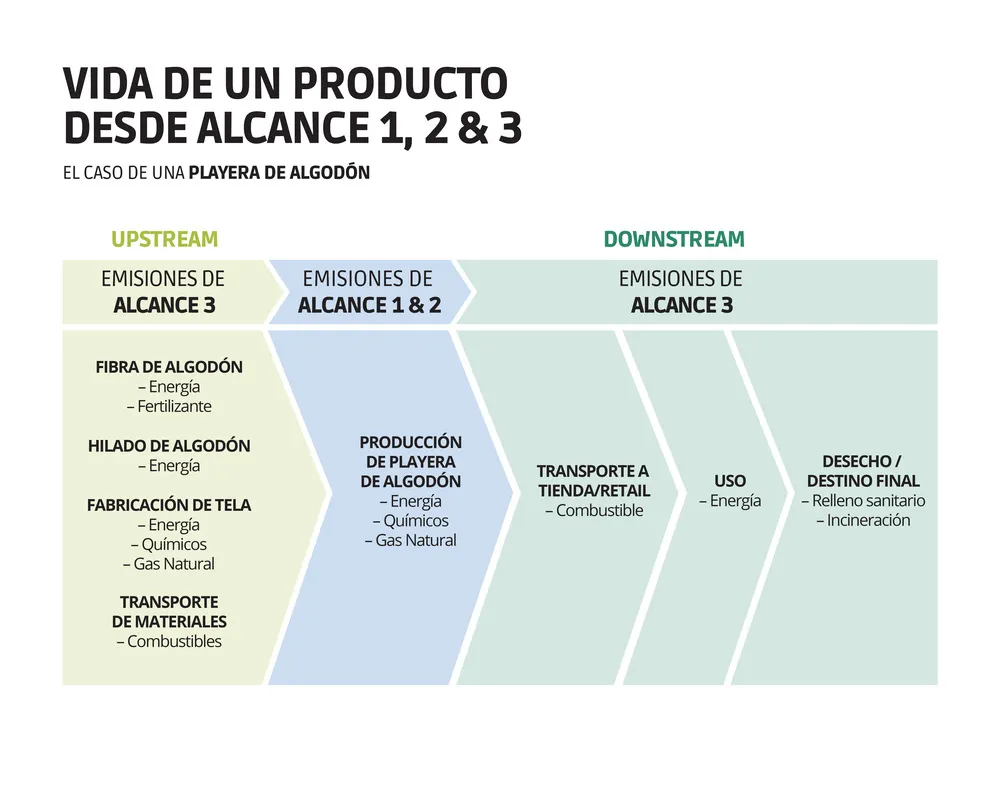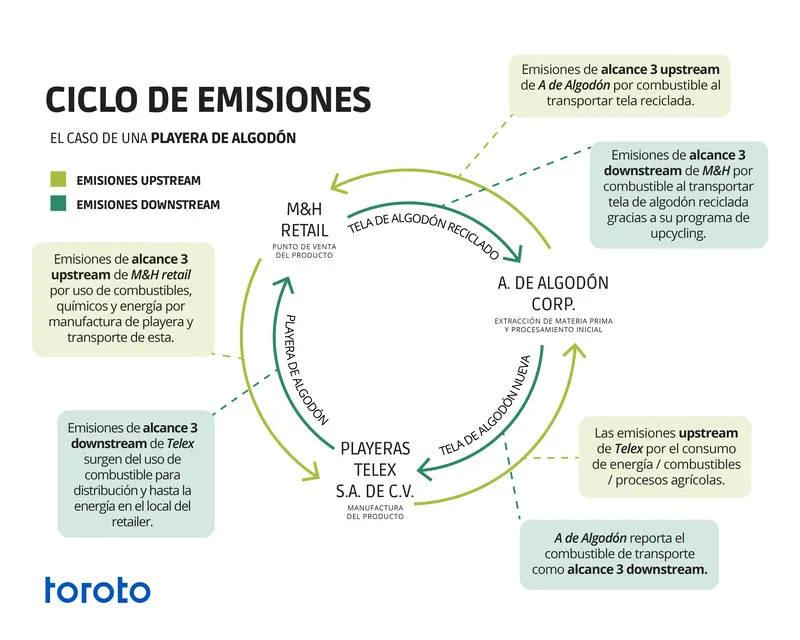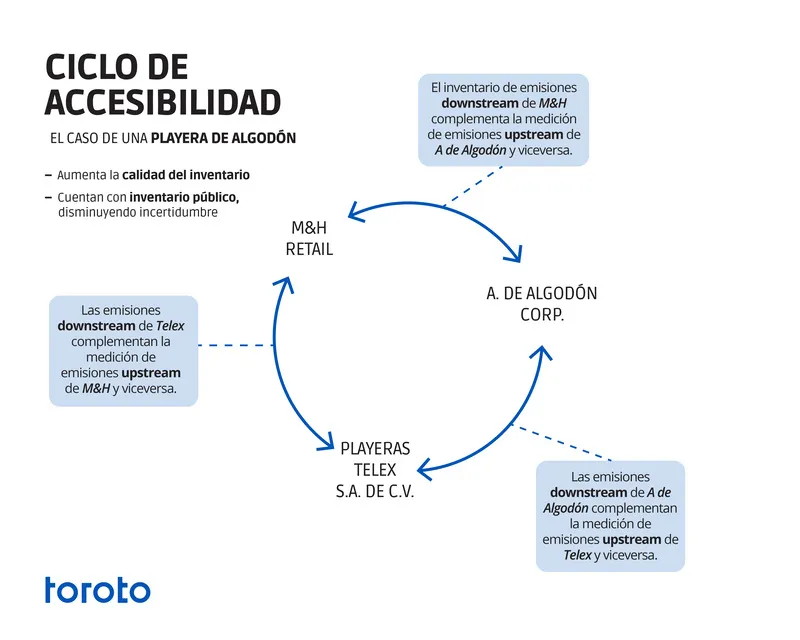The Scope of Your Impact



This article is part of a series of three. Learn more about Scope 2 hither, and about Scope 1 hither.
To understand the climate implications of an action, a product, a service or, in fact, anything we can think of, it is pertinent to ask ourselves first: what makes up the carbon footprint of what we know? To give the most comprehensive answer possible, we must say that the carbon footprint results from the sum of greenhouse gas (GHG) emissions that were involved in the creation, processing, distribution and even disposal of that product, service or thing we are thinking about. Below is the third edition of a series of articles on GHG emissions: the Scope 1, direct emissions; the Scope 2, indirect emissions due to energy consumption and -finally- Scope 3, those other indirect emissions that we haven't talked about yet, and that together make up that original sum. The objective of this series is to take a behind-the-scenes look at the calculation of greenhouse gas emissions -as well as to explain some confusing and complex concepts-, focusing particularly on the use that can be given to such information for decision-making at the corporate, operational and systemic levels. Decision-making that is urgent in the face of the climate crisis we are already experiencing and whose resolution represents -perhaps- the most challenging objective we have faced. We invite you to revisit these articles to refresh the concepts of Scope 1 and 2, so that you can have the full picture.
Scope 3: The Hide and Seek of Impact
The Scope 1 and Scope 2 articles show how GHG emissions are, broadly speaking, under the operational control of a company or organization, allowing not only access to quality information for the execution of a corporate GHG emissions inventory, but also facilitating decision-making for their mitigation.
Las Scope 3 indirect emissions they are another story -and another challenge- because they are broadcasts that come from activities within an organization's value chain (GHG Protocol, s.f.), the amount of actors involved in identifying the sources of emissions, and therefore, their quantities, will be as numerous as the number of “links” that the supply chain has. By supply chain we refer to that set of situations and services that allow the existence of a product, from the obtaining of raw materials to the final distribution of the finished product. This is one of the reasons why it is optional report this scope in a corporate emissions inventory, since the complexity behind gathering information with little uncertainty and quality is a reality (GHG Protocol, s.f.).
Having said that, you may be as alarmed as we are by the fact that for many organizations, Scope 3 emissions can make up to 70% of the operation's total emissions (Deloitte, s.f.). Consequently, achieving a reduction in emissions of this scope would impact different climate objectives that seek to mitigate climate change and the company's contribution to it (GHG Protocol, s.f.), in some cases more than reducing emissions from scopes 1 and 2.
My downstream, you upstream
Despite the challenge, at Toroto, we firmly believe that Knowledge is power, and knowing your sources of emission, as well as the materiality they present, is a first step in overcoming the great challenge that these indirect emissions pose in and of themselves.
The complementary publication to GHG Protocol, the Corporate Value Chain Standard (Scope 3), indicates the existence of 15 categories of emissions to classify supply chain activities, serving as a standardized frame of reference so that organizations can organize, understand and report your Scope 3 emissions faithfully (GHG Protocol, s.f.).
So what are the Scope 3 emissions? The activities that make up this category are located along a company's supply chain, and they can be upstream, upstream, or Downstream, downstream. As outlined in diagram 1, the pursuits Upstream They are all those that happen prior to activities under the organization's control (that is, prior to activities that generate Scope 1 and Scope 2 emissions), for example, if we are measuring the emissions of a brewery, the activities Upstream would be the cultivation of barley and its transport to the brewing plant; on the contrary, pursuits Downstream They are made up of everything that happens after the agency and control of the organization. In the example of the brewery, these could be the emissions generated when processing the beer bottle after a consumer drank it and discarded it. We can understand these concepts more fully in the following diagram, using a cotton t-shirt as an example.

Diagram 1. Simplified example of sources of emission Upstream and Downstream present in the production process of a cotton shirt with the inputs that each activity requires -sources of emission-, such as energy consumption, use of fertilizers and fuel. Las emissions Upstream they arise from everything required to obtain materials, from the cultivation of cotton to the transport of the already processed fabric to the doors of the company that produces the shirt. Once the shirt is produced, the emissions Downstream starting with transportation to the point of sale, until the purchaser uses it, consuming energy every time it washes it, until its disposal. The shirt will end its life incinerated or, more likely, in a landfill where the organic matter inside the jacket will degrade and emit methane as a result of decomposition. As we can see, the entire life of the shirt generates Scope 3 emissions for all the actors involved.
This is how The value chain of an organization or company is made up of activities or sources of emission upstream and downstream, and it is precisely under this notion that we can begin to see the number of actors that play a role in the effort to develop or implement a methodology to identify all the sources of emission present and their quantities. But is there a relationship between the actors? Of course: The emissions Upstream A company's emissions are Downstream from another; The downstream emissions of one are the upstream emissions of another, and so on.

Diagram 2. Example where three companies have circular dynamics in their value chain: the fabric producer A for Cotton It is involved from cultivation to the manufacture of cloth and provides material to the manufacturing company Telex shirts, whose point of sale is the store Retail M&H which, coincidentally, has a cotton fabric recycling program, which it donates to the fabric producer.
Let's imagine that Telex shirts you want to include your Scope 3 emissions in your corporate GHG inventory. To achieve this, it will require information on the activities and emission sources present in the operation of A of Cotton, of M&H and the end of life of the product - which for illustrative purposes, is not included in this scheme. Telex you will have to get answers to questions such as what fuels do they consume and in what quantity? How much energy does it consume? A for Cotton per m2 of fabric what do you provide? What fertilizer do you use to grow cotton? Do they consume refrigerant gas? Each question will probably require the efforts of many people who have the answers within the operation. Sounds complicated, doesn't it?
For many organizations Scope 3 emissions can make up to 70% of total emissions of the operation.
What was outlined in the previous example in diagram 2 shows how the execution (and publication of open access) a company's emissions inventory can positively impact access to quality information for calculating Scope 3 emissions from another organization with which the supply chain is shared. if A for Cotton and M&H they have a corporate GHG inventory to which Telex If you have access, you wouldn't have to go through the process of requesting operational information from other companies. If you don't have access, you would have to rule out emission sources because you don't have any information to approximate your emissions, impacting the relevance of the inventory of Telex. The publication of a GHG inventory supports the generation of a quality information network that gradually reduces the complexity of including Scope 3 emissions in the corporate inventory, creating a kind of cycle of accessibility to information.

Diagram 3. Illustration of the cycle of accessibility to information that can be generated between companies within a supply chain if they have a quality GHG inventory accessible to others.
And with all this, how can we start measuring Scope 3 emissions?
There are a number of steps that can be followed today to approximate a company's Scope 3 emissions. Below we briefly present the recommendations that the Corporate Value Chain Standard (Scope 3) presents as a guide to begin measuring an organization's Scope 3:
1. Mapping the supply chain: identify suppliers of goods and services or any type of actor in the supply chain to later identify the activities they carry out, classifying them into the Scope 3 emission categories.
2. Prioritize activities that fall within inventory limits: once the activities that make up the value chain have been mapped, they must be analyzed with a perspective that ensures the relevance, integrity, consistency, transparency and accuracy of the inventory -Accounting principles of the GHG Protocol. Different criteria are proposed to identify the relevance of activities:
3. Gather Information: information must be collected through the actors in the supply chain to calculate the emissions associated with the inputs of the activity. It is precisely this stage that can be more or less complex depending on the accessibility that relevant information is taken from other actors in the value chain.
Toroto works with methodologies attached to the GHG Protocol that allow us to gradually close the large gap that exists for the identification and measurement of Scope 3 emissions from companies, seeking to contribute directly and indirectly to the generation of information networks that provide quality to corporate GHG inventories.
The Scope of the Impact
“This report (IPCC Sixth Assessment Report) recognizes the interdependence between climate, biodiversity and people, and integrates natural, social and economic sciences more strongly than in previous IPCC reports. It emphasizes the urgency of immediate and more ambitious action to combat climate risks.
Half-measures are no longer an option.”
Hoesung Lee, chair of the Intergovernmental Panel on Climate Change (IPCC)
Half-measures are no longer an option. When we talk about setting climate objectives, we must talk about setting objectives that have a strategy, a feasibility analysis, an action plan, collaboration between parties, and above all, that they are ambitious.
The measurement of GHG emissions at the corporate level becomes increasingly important when the impact that anthropogenic emissions - which arise from human activities - have on climate change is no longer being questioned. The decision-making at the corporate level that springs from knowing the sources of emissions and their magnitude within the operation, can make it possible to create emission reduction projects with relevance and impact not only within the company's operational control -through projects that impact Scope 1 and Scope 2 emissions- but with the potential to impact an entire value chain through the mapping of Scope 3 emissions. Mapping your value chain will facilitate Gradual collaboration in the execution of projects that result in a reduction in emissions associated with the operation of multiple actors.
Emissions Upstream A company's emissions are Downstream from another; The downstream emissions of one are the upstream emissions of another, and so on.
The extent of the impact will go as far as the ambition of the climate objectives goes. If there are companies and even entire industries whose Scope 3 can account for up to 70% of the operation's total emissions, can we continue to create climate change mitigation strategies with long-term objectives that do not include these indirect emissions? Mapping the chain, prioritizing mitigation by emission sources and collaborating with other members of the supply chain, provides a more secure basis for a strategy for decarbonizing an economic sector (Deloitte, s.f.). Omitting Scope 3 emissions from a climate change mitigation strategy, while simpler, delimits the Scope of your Impact.
About the authors:
María is a Carbon Management Analyst in Toroto. She is a physical engineer at IBERO. He is fascinated by archeology, Mexico, the arts and laughing. He believes that together we can do everything.
Juan Carlos is Key Account Manager at Toroto. He is a renewable energy engineer. Enjoy the sea, sports and discover new museums.
References
Greenhouse Gas Protocol. (Corporate Value Chain (Scope 3) Accounting and Reporting Standard; Supplement to the GHG Protocol Corporate Accounting and Reporting Standard. [Online]. Available in: https://ghgprotocol.org/sites/default/files/standards/Corporate-Value-Chain-Accounting-Reporing-Standard_041613_2.pdf
Deloitte. (s.f..). Explained: What are Scopes 1, 2 and 3. Deloitte United Kingdom. [Online]. Available in: https://www2.deloitte.com/uk/en/focus/climate-change/zero-in-on-scope-1-2-and-3-emissions.html
Deloitte. (s.f..) Tackling your value chain emissions. Deloitte United Kingdom. [Online]. Available in: https://www2.deloitte.com/uk/en/focus/climate-change/reducing-scope-3-value-chain-emissions.html
Explore reflections, research and field learning from our work in ecosystem restoration.